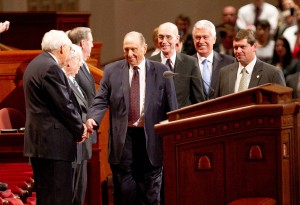The Church of Jesus Christ of Latter-day Saints’ 183rd General Conference was historic for many reasons.

For the first time in history, women offered prayers. A flood of missionaries answered President Thomas S. Monson’s October call to serve. A new General Young Women’s presidency was called. The building of two new temples, particularly one in Cedar City, was announced.
And yet, amid these changes, the Church’s leaders remained stalwart in doctrine, reiterating the importance of obedience to God’s commandments and the immutable consequences of sin.
Against the backdrop of two recent Supreme Court cases that challenge the federal Defense of Marriage Act and Proposition 8, in which California voters approved a law that codified that marriage is between one man and one woman, Elder David A. Bednar taught anew the law of chastity.
“Intimate relations are proper only between a man and a woman in the marriage relationship prescribed in God’s plan,” Elder Bednar said. “Such relations are not merely a curiosity to be explored, an appetite to be satisfied or a type of recreation or entertainment to be pursued selfishly. … We are agents blessed with moral agency and are defined by our divine heritage as children of God, and not by sexual behaviors, contemporary attitudes or secular philosophies.”
In addition, Elder L. Tom Perry emphatically taught that regardless of change in the world, the consequences for disobedience to God’s commandments are unchanging.
“God reveals to his prophets that there are moral absolutes,” Elder Perry said. “Sin will always be sin. Disobedience to the Lord’s commandments will always deprive us of his blessings. The world changes constantly and dramatically, but God, His commandments and promised blessings do not change. They are immutable and unchanging.”
Obedience, too, was the topic of President Monson’s Sunday morning talk.
President Monson, as an 8-year-old boy, was vacationing with his parents in Provo Canyon when he and a friend decided they would clear an area for play — by burning the weeds — despite the fact that they had been forbidden to play with matches. In a panic, they sought help when the fire raged out of control.
“Danny and I learned several difficult, but important, lessons that day — not the least of which was the importance of obedience,” President Monson said. Obedience is necessary not only to our physical safety, but to “our spiritual safety so that we might successfully navigate this often treacherous mortal existence and return eventually to our Heavenly Father.”
Amid the footings of doctrinal constancy, this General Conference was one of change. For instance, for the first time, women offered prayers.
Sister Jean A. Stevens, first counselor in the Primary General Presidency, offered the benediction in the Saturday morning session. Sister Carole M. Stephens, first counselor in the Relief Society General Presidency, offered the invocation in the Sunday afternoon session.
That women would be invited to pray was heralded by Amber Whiteley, an organizer and member of the “Let Women Pray” campaign.
“I think it shows that women’s prayers matter as much as men’s … that women are really important in the Church and that women’s voices matter,” Whiteley told ABC News.
However, the decision to include women was made by church leaders late last year before the “Let Women Pray” campaign was launched, said church spokesman Scott Trotter in a statement.
Nonetheless, women across the Church celebrated the change.
“Now I can tell my children that I have witnessed the first time in my life a woman praying in conference,” commented Bryttney Baird on the “Let Women Pray” Facebook page.
Change was also the watchcry following President Monson’s October announcement that lowered the age of missionary service. It inspired almost immediate change in the lives of men and women who flooded Church headquarters with missionary applications.
Elder Neil A. Anderson, with amazement, noted that Church headquarters began to receive missionary applications five days after President Monson’s announcement. Prospective missionaries had responded to the call almost immediately by visiting doctors, their bishops and stake presidents to complete the application process in so short a space of time.
Six months later, more than 65,000 full-time missionaries are serving in over 150 countries and territories. In addition, 20,000 missionaries have been called to serve and 6,000 are in the application process, President Monson said. The Church recently announced 58 new missions, bringing the Church’s mission count to 405; it also announced a new MTC in Mexico.
In addition, just prior to General Conference, the Church announced the formation of Mission Leadership Councils — one in each mission — that will include the mission president and his wife, assistants to the president, zone leaders and sister training leaders, which is a new role for sister missionaries.
During conference a new General Young Women Presidency was called: Bonnie Lee Green Oscarson was called to be the new president, with Carol Louise Foley McConkie as her first counselor and Evelyn Neill Foote Marriott as second counselor. These three women will replace the former presidency of Elaine S. Dalton, Mary N. Cook and Ann M. Dibb, who have served together since April 2008.
There were also other developments during General Conference. Saturday morning, President Monson announced plans to build two new temples: one in Rio de Janeiro and one in Cedar City. It was noted that there are currently 140 temples in operation, with 29 under construction.
The newly announced temple in Rio de Janeiro will be the eighth planned or operating temple in Brazil, where there are more than 1.1 million Latter-day Saints. The planned temple in Cedar City will be the 17th temple operating or planned in the state of Utah, where nearly 2 million members live.




